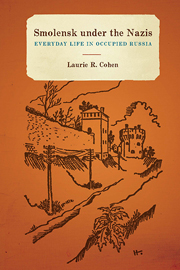Book contents
- Frontmatter
- Contents
- Acknowledgments
- Abbreviations
- Introduction
- Part 1 Methodologies
- Part 2 A Record of the War and Occupation
- 2 Between Invasion and Liberation: Everyday Life and Loyalties Prior to the German-Soviet War
- 3 Defense and Surrender of Smolensk
- 4 “Normalcy”
- 5 Occupation Atrocities and War Crimes
- Part 3 Popular Attitudes, Propaganda, and Enemy Imagery
- Part 4 Restoration and Reconstruction
- Conclusion
- Notes
- Bibliography
- Index
4 - “Normalcy”
from Part 2 - A Record of the War and Occupation
Published online by Cambridge University Press: 05 December 2013
- Frontmatter
- Contents
- Acknowledgments
- Abbreviations
- Introduction
- Part 1 Methodologies
- Part 2 A Record of the War and Occupation
- 2 Between Invasion and Liberation: Everyday Life and Loyalties Prior to the German-Soviet War
- 3 Defense and Surrender of Smolensk
- 4 “Normalcy”
- 5 Occupation Atrocities and War Crimes
- Part 3 Popular Attitudes, Propaganda, and Enemy Imagery
- Part 4 Restoration and Reconstruction
- Conclusion
- Notes
- Bibliography
- Index
Summary
I told [General] Schenckendorff that we don't need a population that is filled with hate at our backs, and thus we must seek ways of bringing the people to want to work as a team…. We've been successful with returning Sundays—for films, outdoor markets, churches. Schenckendorff agrees.
—General Fedor von Bock, commander of Smolensk's Army Group Center, 1942For the majority of Smolensk civilian residents who did not flee or were not evacuated—from a mere 1,000 in early August 1941, to an average 20,000–30,000 over the course of the next two years—the transition to a new authority was gradual yet forced, symbolic yet profound. With time, the city found new rhythms, and some residents accommodated themselves well to them. One representative example of change is the mayor's order of December 30, 1941, calling for 224 new Smolensk street names, excluding streets in the area of the ghetto, which were now “beyond” the city's borders. These new names were all German ones, requiring Russian translations (e.g., Sovetskaia ulitsa became Hauptstrasse/ Glavnaia ulitsa).
First Days
The German military and political leadership entering Smolensk in mid-July 1941 expected to find a major railway junction, along with an electric power plant, a post and telegraph office, two typography plants, a state bank, a radio station, several airplane barracks, and an airport, various automobile factories, iron works, flax and spinning factories, woodworks, a textile factory, bast (fiber) works, and a beer brewery.
- Type
- Chapter
- Information
- Smolensk under the NazisEveryday Life in Occupied Russia, pp. 61 - 95Publisher: Boydell & BrewerPrint publication year: 2013



